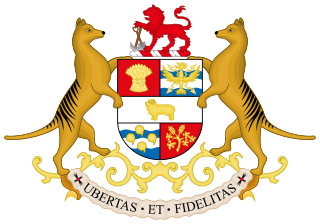Related Research Articles

The Parliament of Tasmania is the bicameral legislature of the Australian state of Tasmania. It follows a Westminster-derived parliamentary system and consists of the governor of Tasmania, the Tasmanian House of Assembly, and Tasmanian Legislative Council. Since 1841, both Houses have met in Parliament House, Hobart. The Parliament of Tasmania first met in 1856.

The electoral division of Windermere is one of the 15 electorates or 'seats' in the Tasmanian Legislative Council. The division is located on the East side of the Tamar River. It is named after the town of Windermere which is located along the banks of the river between Launceston and George Town.

The electoral division of Rosevears is one of the 15 electorates or 'seats' in the Tasmanian upper house. The division is located on the west side of the Tamar River. It is named after the town of Rosevears which is located on the river banks near Exeter.
Kerry Finch is a former member of the Tasmanian Legislative Council or upper house for the electoral division of Rosevears, which mainly comprises the western side of the Tamar River valley from West Launceston up to Greens Beach. He was first elected on 4 May 2002, and retired in 2020.

The electoral division of Pembroke is one of the 15 electorates or 'seats' in the Tasmanian Legislative Council or upper house. It is located on Hobart's Eastern Shore and includes a number of suburbs; Risdon Vale, Geilston Bay, Rose Bay, Lindisfarne, Warrane, Mornington, Bellerive, Howrah and Tranmere. In earlier times, the division included most of the east coast of Tasmania as far north as Bicheno, including the Tasman Peninsula.

The electoral division of Rumney is one of the 15 electoral divisions in the Tasmanian Legislative Council. The division is located in Southern Tasmania to the east of the division of Pembroke.

The electoral division of Derwent is one of the 15 electoral divisions in the Tasmanian Legislative Council. It is situated in the central south of the state.

The electoral division of Nelson is a constituency of the Tasmanian Legislative Council. The division includes many of the suburbs to the south of Hobart, including South Hobart, Sandy Bay, Taroona and Kingston. The division was created in 1999 when the electoral division of Queenborough was renamed in a review of electoral boundaries. The member from 1999 until his retirement in 2019 was independent Jim Wilkinson.

The electoral division of Murchison is one of the fifteen electorates in the Tasmanian Legislative Council, situated in the western/north-west region of the state. It is the largest electorate in size, covering an area of 19,391 km² and includes the municipalities of Circular Head, King Island, Waratah-Wynyard, West Coast and part of Burnie City.

The Electoral division of Huon is one of the 15 electoral divisions in the Tasmanian Legislative Council. It was created in 1999, however similar electorates of this name have existed since 1900, and members of the Tasmanian upper house for this region appear to have been elected since 1856.

The Tasmanian Legislative Council has fifteen single member constituencies, called divisions.

The electoral division of Mersey is one of the fifteen constituencies in the Tasmanian Legislative Council. The division covers an area of 732 km2.

The electoral division of Launceston is one of 15 electorates or seats in the Tasmanian Legislative Council, created in 2008. It also previously existed until 1999, when it was abolished and substantially incorporated into the new division of Paterson, which was in turn abolished in 2008.
The electoral division of Cornwall was an electoral division in the Tasmanian Legislative Council of Australia. It was abolished in 1999 after the Legislative Council was reduced from 19 members to 15.

The electoral division of Elwick is one of the 15 electoral divisions in the Tasmanian Legislative Council. The division covers most of the municipality of Glenorchy.

The electoral division of Hobart is one of the 15 electoral divisions in the Tasmanian Legislative Council. It was originally created in 1856 when the Council became the upper house of the Parliament of Tasmania. The seat was abolished in 1999 and re-created in 2008 after a redistribution saw the former division of Wellington returned to its former name.
The Electoral division of Roland was an electoral division in the Tasmanian Legislative Council of Australia. It existed for two years from 1997 to 1999 and never faced an election. The seat was a renaming of the old seat of Tamar, which was then renamed Rowallan.

The electoral division of McIntyre is one of the fifteen electorates in the Tasmanian Legislative Council, it includes Flinders Island, the northern east coast of Tasmania, and regional areas south and west of Launceston. It is named after Margaret McIntyre, who was the first woman to be elected into the Parliament of Tasmania in 1948.

The electoral division of Prosser is one of the fifteen electorates in the Tasmanian Legislative Council, it includes the south-east coast of Tasmania, the Sorell township and the Tasman Peninsula. Prosser is named after the Prosser River, which flows through the centre of the division.
Periodic elections for the Tasmanian Legislative Council were held on 5 May 2018. The two seats up for elections were Hobart and Prosser. Hobart was previously contested in 2012. Prosser was a new division created in the 2017 redistribution, and was vacant pending this election.